
31 Marketing Trends You Need to Know for 2024
What are the most important 2024 marketing trends we’ll likely see?
To make a solid plan for the short term, it’s important to keep an eye on where you’re heading in the long term. Nobody can say with 100% certainty what the future of marketing will look like, but industry professionals can offer useful insights and predictions into some of the possibilities.
Nobody could have predicted how 2020 would change the face of marketing. Or how Chat-GPT would have brought AI in Marketing to the top of the list of marketing trends in 2023. So what’s the next big thing in marketing?
Before we get to that, let me answer the number one question we have gotten recently: how is our content marketing agency doing?
After tripling revenues for our weekly blog content service since 2020, 2023 was more of a flat year for us until recently. 🤷♂️ Because as more businesses realized that content marketing is the most predictable way to generate a return on marketing, we have seen a nice recent return to growth. We are especially seeing growth in our content amplification (hence the article) because it is giving our clients predictable growth on an efficient budget.
Now, where are we headed with marketing trends in 2024? While technologies such as AI and predictive analytics continue to grow, the overarching focus will be on people, not technology.
Quick Takeaways:
- The marketing trends that will dominate in the next 12 months will all have an AI component as AI becomes “baked-in” to everything we do
- CMOs are under fire and will continue to support the need for Marketing to focus on and demonstrate ROI.
- The very definition of marketing needs to re-focus on how we add strategic business value and are not just people who do stuff
- Marketing has moved beyond branding and advertising; digital display will evolve to more of a social commerce vibe.
🔥 PS – I put together these 10 tips for optimizing your content marketing. Watch Now!
AI-Based Marketing Automation
Will 2024 be the year of the rise of the robots? Maybe (but hopefully not in the Terminator-style of dystopian science fiction movies!)
Remember Marketing Automation has been around for decades. The rise of AI technology is simply automating more of the mundane tasks that marketers should be doing. Think A/B test copy versions, multiple variations of social posts, etc. We’ve already seen huge advancements in AI over the last few years, and a great increase in the number of businesses using AI-powered technology and automation to assist their marketing efforts.
AI is one of the major technologies behind voice search and smart assistants. It’s also made chatbots possible, which are now popping up on more websites than ever before. AI technology and automation are helping to take some of the grunt work out of marketing so brands can concentrate on strategy and crafting a fantastic customer experience.
And there has been a ton of progress made this year on AI-based image enhancement (please stop sharing 9 images of your AI-face on social) and AI-writing tools. (Check out our experiment using AI-based writing tools here.) Our key takeaway: humans are going to continue to be important to content creation and marketing for the foreseeable future.
Remember, the human aspect of marketing is still important (perhaps more important than ever before), so the idea is to use this technology to enhance your marketing efforts, not replace the real people behind them. I call this the Paradox of AI: the more technology marketers use, the more human our audiences are going to want us to be!
Big data, supported by AI and predictive analytics, is also helping brands to learn more about their audience and customers. It’s enabling hyper-personalization of customer experiences and marketing messages at scale.
Take-away: AI will be embedded in everything we do as marketers: from customer research and persona development, to short-form content creation, content distribution, campaign automation, and predictive analytics.
The AI Paradox: Balancing Automation and Humanity
In today’s digital landscape, AI is more prevalent than ever, automating everything from customer service to marketing campaigns. But here’s the kicker: As we lean more into automation, consumers are craving genuine human interactions. A study by Calabrio found that 75% of consumers in the US and UK are more loyal to businesses that offer the option to interact with a human, not just a chatbot.
The secret sauce to resolving this paradox? Organizational empathy. Brands that successfully blend AI’s efficiency with a layer of human empathy are not just improving customer satisfaction; they’re also seeing a boost in ROI and brand loyalty.
As we move into 2024, the challenge for marketers will be to find that sweet spot between automation and genuine human connection. Because let’s face it, in a world run by algorithms, being human is our competitive advantage. Here is my favorite example from Cleveland Clinic who does a great job of pulling empathy into the healthcare world dominated by technology and not well known for their bedside manner:
The Declining Role of Social Media in Website Traffic
If you’re still banking on social media as your primary source for website traffic, it’s time for a reality check. Our extensive research shows that social media’s contribution to website traffic has plummeted from 7% in 2019 to less than 2% in 2023. Yep, you read that right!
The Data Speaks
- Organic Search: Still the king, accounting for over 60% of all web traffic.
- Direct Traffic: On the rise, contributing 22% of website traffic, up from 15% in 2019.
- Social Media: A steep decline from 7% in 2019 to just 2% in 2023.
- Paid Media: Also down, from 10% in 2019 to 3% in 2023.
- Email: Following the trend, down from 10% in 2019 to just 3% in 2023.
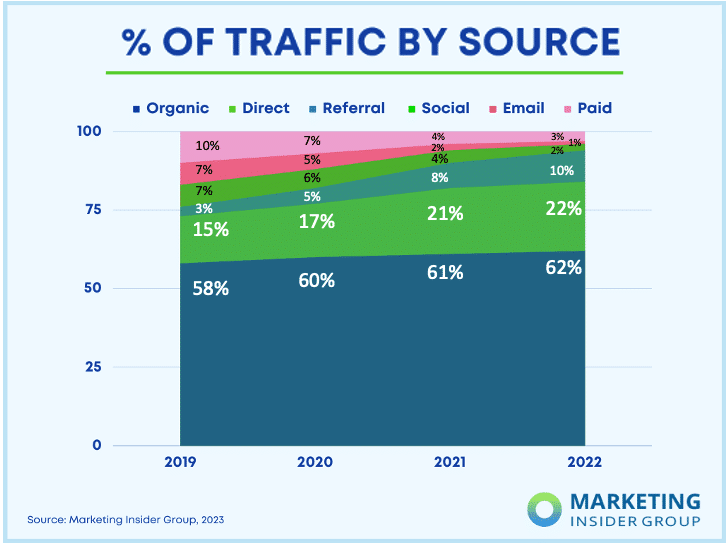
What This Means for Marketers:
- Rethink Your Social Strategy: If you’re pouring resources into social media to drive website traffic, it might be time to reassess. Our advice is to minimize your effort here but don;t abandon the networks completely. (See LinkedIn section below)
- Double Down on Organic: With organic search still reigning supreme, focusing on SEO and content marketing is a no-brainer.
- Don’t Ignore Direct and Referral Traffic: These sources are showing growth, so consider strategies to leverage them.
As we move into 2024, it’s clear that the old ways of driving traffic are evolving. Marketers need to adapt and diversify their strategies, focusing more on organic and direct traffic sources while not completely abandoning social media, but certainly re-evaluating its role.
LinkedIn Strategy for B2B Marketers: The New Frontier
Why LinkedIn?
As social media’s role in driving website traffic dwindles, LinkedIn emerges as a beacon for B2B marketers. It’s not just a platform for job hunting; it’s a goldmine for quality leads and meaningful engagement. Here’s how to be successful in 2024
- Consistent Content: Gone are the days when you could post sporadically and expect results. Consistency is key. Share valuable insights, industry trends, and company updates to keep your audience engaged.
- Live Video: Live video is the new black. It’s real, it’s raw, and it gets people talking. Use it for product launches, behind-the-scenes looks, or Q&A sessions.
- Engagement: Don’t just post and ghost. Respond to comments, engage in conversations, and don’t shy away from sliding into those DMs when appropriate.
- Personal Branding: Encourage team members to share and engage with company content. It amplifies reach and adds a personal touch
- Quality Over Quantity: It’s better to have 500 engaged followers than 5,000 who don’t interact. Focus on building a community, not just a follower count.
Content Amplification: The Smarter Way to Drive Engagement
Why It’s Better Than Ads
Let’s be real: Nobody wants to see ads for products anymore. But what people will click on is a related article when they’re already reading something else. That’s where content amplification shines. It’s not about pushing a product; it’s about promoting valuable content that resonates with the reader.
How We Do It: The Zemanta Magic
At Marketing Insider Group, we use Zemanta to drive a high volume of engaged readers and conversions at a super low CPC. Why does this work? Because we’re not advertising a product; we’re advertising an article. We then retarget these engaged readers for conversions.
The AI Advantage
The secret sauce here is AI. Zemanta uses AI to find the right people who are already reading related content. So, instead of throwing your content into the void and hoping for the best, you’re strategically placing it in front of people who are already interested in what you have to say. Check out how well this performs for one of our favorite clients:
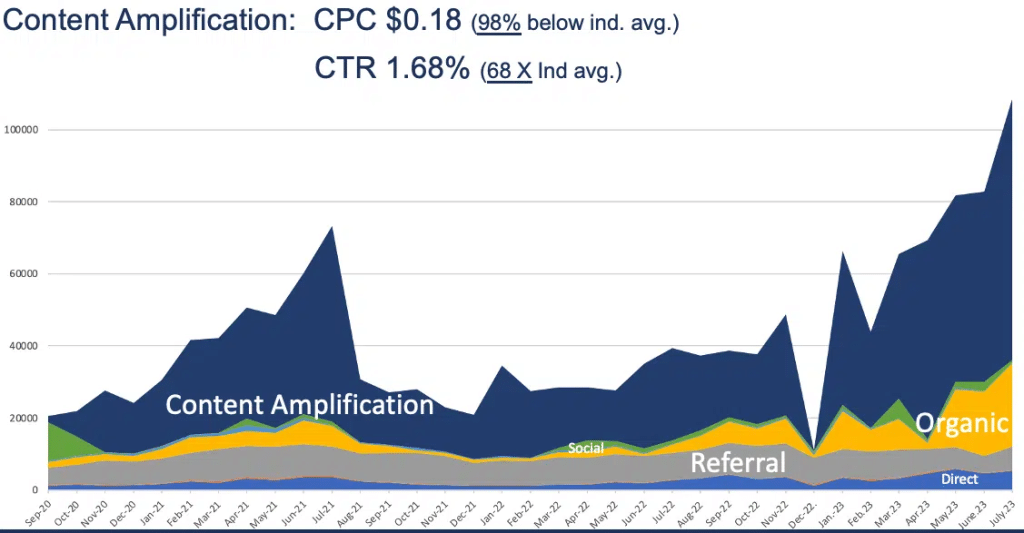
🚀 PS – Check out our weekly blog content service to grow your website traffic and leads!
First-Party and Intent Data: The New Goldmine for Marketers
The Shift to First-Party Data
Say goodbye to the days of relying solely on third-party data. With increasing privacy regulations and the demise of third-party cookies, first-party and zero-party data is now the MVP in the marketing game. This is data you collect directly from your customers—think email sign-ups, purchase histories, and website interactions. It’s not just compliant; it’s also more accurate and actionable.
The Power of Intent Data
While first-party data tells you who your customers are, intent data reveals what they’re likely to do next. This is the crystal ball that helps you predict consumer behavior, from what they’re searching for online to the content they’re engaging with. In 2024, intent data is not just a nice-to-have; it’s a must-have for any serious marketer.
How to Use Them in 2024
- Personalization: Use first-party data to personalize everything from email campaigns to website experiences. The more tailored the experience, the higher the conversion rates.
- Predictive Analytics: Combine first-party and intent data to forecast customer behavior. This can help you optimize your marketing spend and focus on high-ROI activities.
- Privacy First: Always be transparent about how you’re collecting and using data. Not only is this good ethics; it’s also becoming a legal requirement.
As we venture further into 2024, expect to see even more sophisticated tools for collecting and analyzing first-party and intent data. But remember, with great data comes great responsibility. Ethical data usage will be the differentiator between brands that merely survive and those that thrive.
Search Generative Experience: The Future of Online Discovery
Move over, Featured Snippets; there’s a new player in town. Generative Search Experience is set to redefine how we interact with search engines and online platforms. Powered by Generative AI, this trend is all about creating a more dynamic, personalized, and interactive search experience.
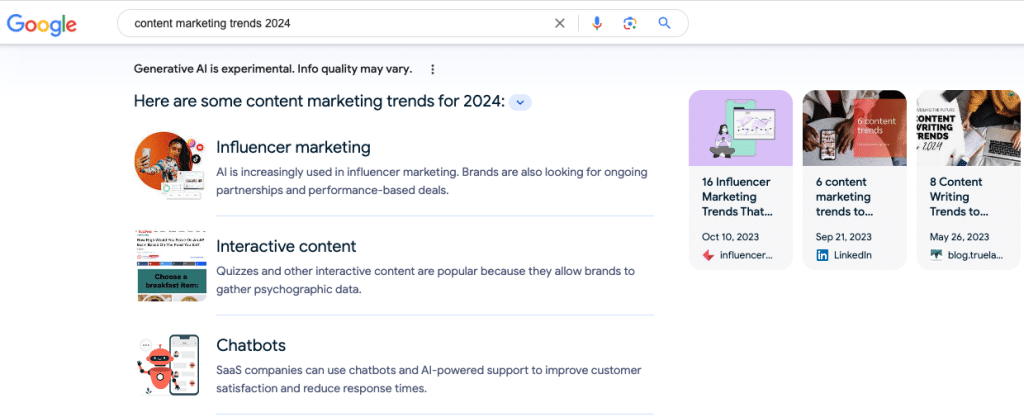
Why It’s a Game-Changer
Generative AI is already a hot topic, and tech giants like Microsoft, Google, and Meta are investing heavily in it. The technology has the potential to democratize access to information and transform how we search online. Imagine a search engine that not only finds what you’re looking for but also creates content on the fly based on your query. Mind-blowing, right?
Beyond Text-Based Search
Generative Search isn’t just about text; it’s multi-modal. This means it can understand and generate various forms of content, including images, audio, and video. So, you could potentially ask a search engine to show you a video that explains a concept, and it could generate one for you in real-time.
The Rise of Generative Commerce
This technology will also impact e-commerce platforms. Imagine searching for a product and having the platform generate personalized recommendations, complete with custom video demos or interactive 3D models. The possibilities are endless.
Ethical Considerations
While the technology is exciting, it also raises ethical questions, especially around misinformation and data privacy. As generative AI becomes more prevalent, there will be ongoing debates about its responsible use.
Generative Search Experience is still in its infancy, but it’s a trend that’s worth keeping an eye on. As AI models become more sophisticated, we can expect to see more disruptive innovations in this space.
The Next Generation of Account-Based Marketing
Account-based marketing personalizes messaging to businesses, targeting each decision-maker with the information they need to solve specific departmental problems. Like personalized messaging directly to customers, account-based marketing yields a higher ROI than other types of marketing. If you sell to other businesses, particularly large corporations, account-based marketing is one of the “already here” digital marketing trends you need to embrace during the coming years.

Here are 5 things to consider in your 2024 marketing strategy as it relates to Marketing Automation:
- Fuel Your ABM Strategy with Intent Data: Intent data is becoming a cornerstone in ABM. It helps you identify high-value companies that are actually interested and more likely to convert. This is crucial for targeting the right accounts and building audiences for your ABM campaigns.
- Hyper-Personalization: Forget generic messages; hyper-personalization is where it’s at. The idea is to deliver value at every touchpoint based on deep insights into individual needs and pain points. This can significantly improve customer engagement and conversion rates.
- AI-Driven Tools for Smarter ABM: AI is making ABM more efficient by analyzing vast amounts of data and identifying patterns. This enables you to direct your resources more effectively and engage your target accounts more precisely.
- Sales and Marketing Alignment: ABM is a team sport. Aligned teams work better by closing deals faster and contributing to revenue growth. Regular cross-departmental meetings and shared dashboards can help maintain this alignment.
- Optimize Full-Funnel Metrics: It’s not just about bringing potential clients into the funnel; it’s about guiding them through it. The new directive is to assess ABM’s impact across the full sales funnel, from lead generation to closing deals.
Martech: Consolidating or Proliferating?
The Big Question we have been discussing for a while is if the dizzying martech landscape will consolidate into a few big players, or is it proliferating into a myriad of specialized tools? Scott Brinker, a leading voice in the martech space, suggests it could go either way, especially with the advent of AI.
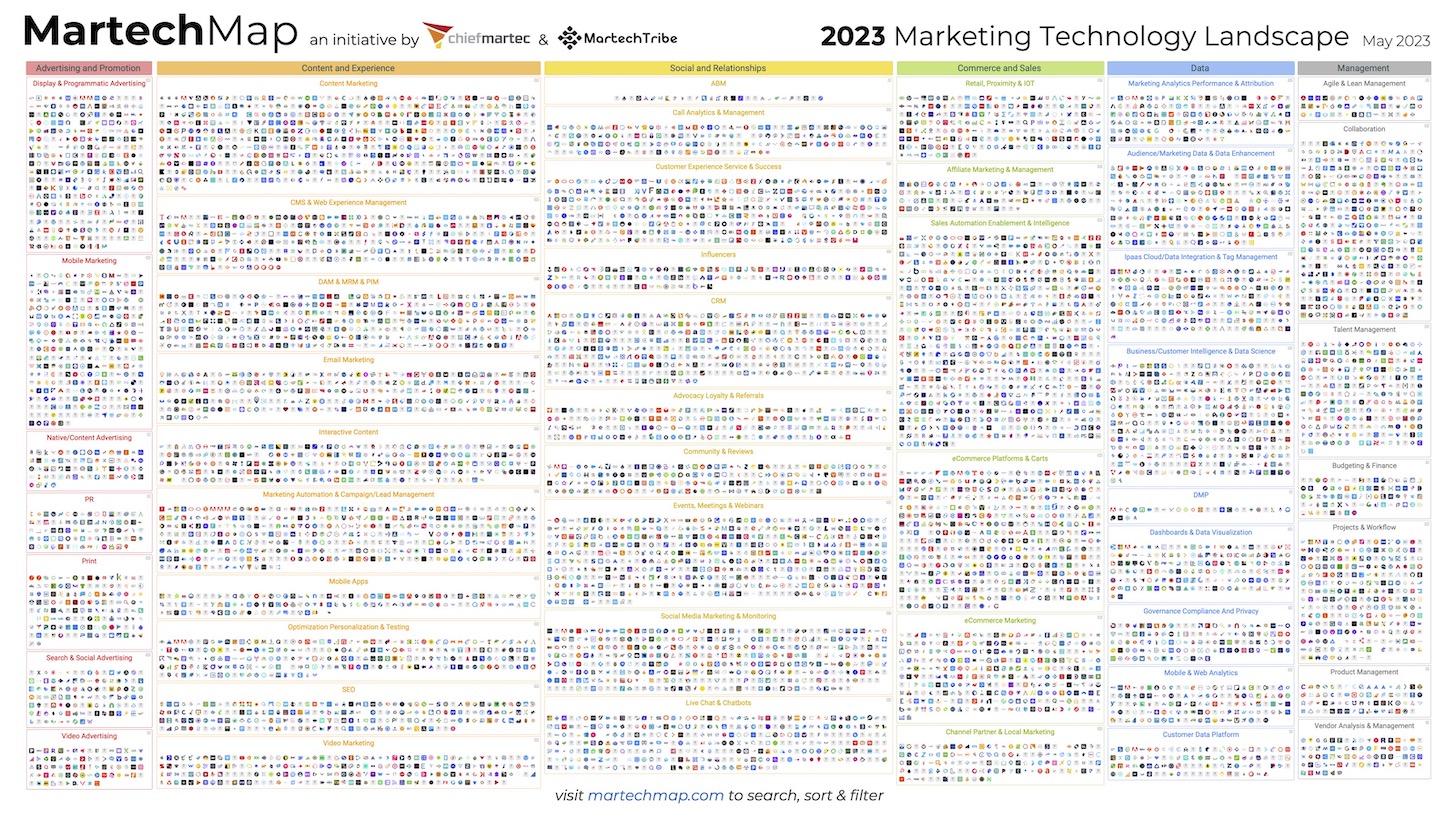
A Coupe of Scenarios
- The Rise of Super Apps: AI could enable a few big vendors to offer ‘do-it-all’ platforms, simplifying the martech stack but potentially stifling innovation.
- Custom-Built Martech: AI-powered low-code/no-code platforms could democratize software creation, allowing brands to build custom solutions tailored to their unique needs.
- A Martech Explosion: The most likely scenario, according to Brinker, is a proliferation of both custom and commercial software, driven by AI innovations.
What This Means for Marketers
- Be Agile: The only constant is change. Be ready to adapt your martech stack as the landscape evolves.
- Invest in Skills: Whether it’s managing a super app or building custom solutions, the right skills will be crucial.
- Keep an Eye on AI: AI will be the game-changer, influencing which of these scenarios will become reality.
Strategic Marketing Transformation
CEOs expect Marketers to demonstrate business results in a way they (and the CFO) can understand.
So when you’re reading about up-and-coming trends in an article like this, it’s all too easy to think that being successful in marketing can be simplified to following a list of best practices and making sure you’re using the latest techniques and technology.
The business of marketing is becoming increasingly complex. For companies to succeed in 2024, they’ll have to think beyond what they’re doing and link everything back to the why of the business as a whole. Your marketing goals and objectives must align with the overall goals of your business. That means revenue growth and new customer acquisition.
Strategic marketing transformation is the term used to describe the process when a business operating without a strategic marketing plan evolves by changing its fundamental business processes and procedures.
Undergoing a marketing transformation can help companies to improve customer service and experience, boost brand awareness and reputation, and ultimately increase revenue and profits.
Businesses achieve these benefits through a combination of data collection, using modern technology, building customer relationships and engaging with customers online, publishing quality content, and improving their online presence. All of these things are part of the underlying strategy that influences every department and employee in the company, not just the marketers.
Your strategic marketing plan defines goals and determines which marketing tactics you will employ to reach your customers including content marketing, SEO, email marketing, social media, advertising, and offline marketing. It then lays out a plan for how every part of the organization will be involved in these tactics.
To put it simply, the marketing strategy is no longer only the responsibility of the chief marketer or CMO. Strategic marketing transformation recognizes this and ensures that the brand, company reputation, customer relationships, and the customer experience as a whole are considered in every business activity.
Social Commerce
Social commerce isn’t new, but it is finally becoming a mainstream form of shopping. Brands are becoming savvier than ever about leveraging influencer marketing, creating ads that fit seamlessly into social media feeds, and integrating their e-commerce marketing strategy platforms with social media channels.
Instagram and Tik Tok have been particularly influential in accelerating the social commerce trend. Instagram Checkout makes it easier than ever for brands to advertise and sell their products directly through the platform.
Tik Tok is absolutely changing the game when it comes to influencer marketing with tools like Creator Marketplace, where brands can find creators that align with their products and interests, and Tik Tok Shopping, which allows brands to more meaningfully engage with customers right through the app.
Research by Statista shows that social commerce is on the rise for 2024 and not slowing down any time soon.
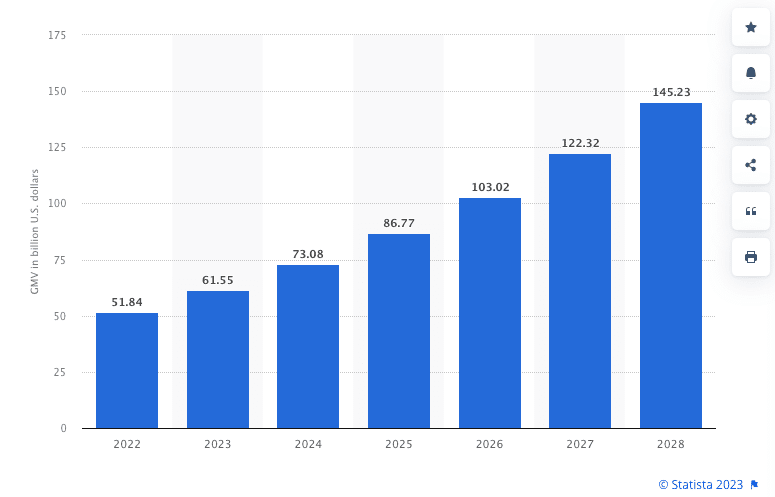
Employee Activation: A Giant Leap Beyond Engagement
If efficient and friendly service is the cornerstone of great customer experience, how do you ensure you’re providing this? The answer, of course, is in your employees. The previously mentioned research also found that 46% of consumers will abandon a brand if its employees are not knowledgeable, and bad employee attitude is the number one factor that stops individuals from doing business with a company.
I call this employee activation. Your employees are the human face of your brand, so concentrating on interactions between your employees and your customers should be a key part of your marketing strategy. When you’re turning the responsibility of creating a great customer service over to your employees, you need to make sure that they want your business to succeed as much as you do.
The key to this is building a solid foundation of employee engagement and taking steps to ensure every employee understands and is aligned with your brand mission and values.
You can’t expect your employees to care about your customers if they’re not happy at work and don’t really believe in what you’re doing as a business. So achieving a high level of employee engagement is the first and most important step in improving customer experiences.
Employee engagement requires you to make your workplace such an attractive place to work that your employees’ happiness will spill on over onto the customers. Indeed, a smile and an extra effort to please that comes from the heart is one of the most effective forms of marketing out there. In fact, companies that engage their employees outperform their peers by a factor of two.
However, that one giant leap for humankind – walking on the moon – is a piece of cake compared to convincing some companies to treat their employees like valuable colleagues instead of glorified house servants. Taking the next step – employee activation – requires you to treat your employees as your most treasured customers.
When you activate your employees, though, it’s marketing magic. Activation includes a wealth of tools to empower your employees to become walking billboards for your company, including:
- Training that not only makes them more informed about your products, but also allows them to climb up the corporate ladder – imagine – you gotta love a company that trains you to qualify for a better job
- Permission to post content on social media and elsewhere about your company’s culture, products, and services
- Involvement in creating blog posts, videos, white papers, and other “official” marketing content, creating a platform on which they can showcase their expertise
Once your employees start sharing the love your company has shared with them, it will pay off. Not only will it pay off in good vibes, but it will also likely make a huge impact on your bottom line.
In fact, leads that your employees generate through social media marketing posts are seven times more likely to convert than leads you generate through other channels, according to Sociabble. In addition, content that they share will enjoy eight times more engagement than content that you share on your official brand channels.
Data Everywhere
Over the next decade, this trend will ramp up even more as it becomes the norm for everyday devices and embedded technology to keep everyone connected all the time. Privacy issue are certainly a concern but the use of apps like Life360 show that youger generations don’t mind being tracked if it’s for a clearly understood purpose.
Smartphones, smartwatches, and smart TVs are already commonplace. The technology is becoming smaller and cheaper all the time. In the not-too-distant future, it’s likely that almost every electronic device will be “smart” in some way. Even more striking, smart microchips are already being implanted in humans.
Smart cities – urban areas that use IoT technology to manage resources and services – are also on the rise globally. It’s estimated that by 2025, the top 600 smart cities will account for 60% of the world’s GDP.
This massive number of connected objects will generate a huge quantity of data that can be used to gain advanced customer insights. This information can then be used to personalize the customer experience and provide easier communication and engagement with the brand.
Story-Driven Content Visualization
With the explosion of smart speakers and voice search in recent years, you’d be forgiven for thinking that “readable” content is more important than visuals and design these days.
In fact, this couldn’t be further from the truth. While advancements in voice search are certainly influencing the way that we’ll create content now and in the future, you shouldn’t neglect visual content and the basic elements of brand storytelling.
Research has shown that people prefer visual content to plain text. You just have to look at the growth of image-focused platforms Pinterest and Instagram to see the proof of this.
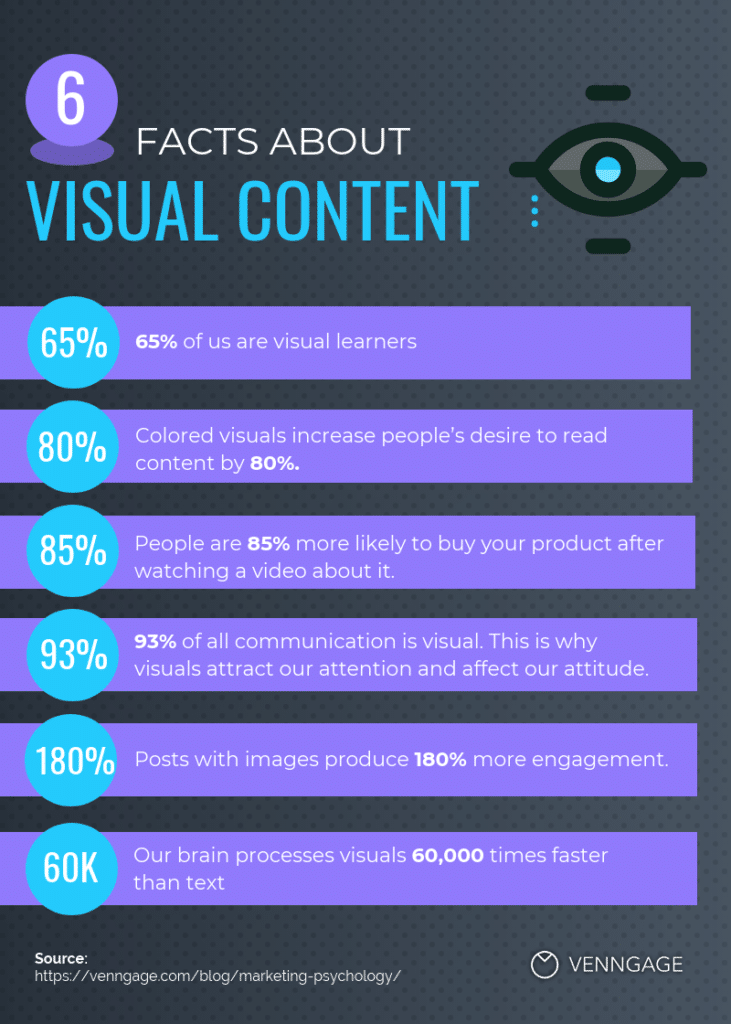
Visuals are also easier to remember than written content. Adding data visualizations, infographics, images, and videos to your text not only makes it more interesting and attractive, but it can help your message to be absorbed better too.
❤️ PS – Check out our latest case study that shows how we helped one company double their leads!
Personalization: Your Key to Their Heart
When a customer has two relatively equal products in front of her, and she needs to decide which one she’ll buy, my money’s on the brand that won her heart. One of the ways to engage your customers’ hearts as well as their heads is to personalize marketing to meet their needs.
For years, psychologists have taught us that people love to hear their name and see it in print. But today’s technology allows digital marketing teams to dig deep into the data to identify the things that keep customers up at night – and identify what messages will solve those problems and give them a good night’s sleep.
In the 2002 movie Minority Report, the character John Anderton, played by Tom Cruise, is bombarded by a series of personalized ads calling him by name as he walks through the city. This was obviously complete science fiction at the time, but not quite two decades later, reality has almost caught up with the marketing future of Stephen Spielberg’s imagination.
Today’s consumers are flooded with marketing messages from multiple channels to the point where they have started to tune them out. Traditional advertising is losing its effectiveness, so what’s the answer? Personalized marketing messages that forge a real connection between the brand and the target market. So, go way beyond the “Hi [Customer Name]” emails, “Don’t you want to make more money?” popups, or “Hey, come back here!” cheesy messages in the browser titles to find what makes your customers tick. Then, give them content that will win their hearts.
Again, a little effort will yield amazing results. In fact, 80% of consumers said that they’d be more likely to do business with a brand that provides a personalized experience, as per a survey by Epsilon.
Improvements in technology such as AI combined with increased data collection and insights from social media and other sources have made it possible and easy to hyper-personalize everything from content to design to product recommendations and everything in-between.
Voice Search: Evolving and Improving
I’ve mentioned voice search a couple of times already, so you knew it was going to be on this list. Voice search shows no sign of slowing down and will continue to be a major influence on how brands create content and market themselves online.
We’re not quite at the commonly cited prediction that 50% of searches will be driven by voice in 2023 (we’re currently sitting at about 20% according to Google), but this statistic is probably not that far in the future. The smart speaker business is booming, with around a quarter of US households now owning a Google Home, Amazon Echo, or another smart speaker.
Consumers are also expecting to use voice search more in the near future – 61% of those aged 25–64 who already use a voice device intend to use it more in the future according to research by PwC.
Voice search brings with it new challenges but also exciting opportunities. “Branded skills” is one example of a smart speaker advertising opportunity that emerged in the last year. Tequila brand Patròn is an example of a company that’s seen huge success from using branded skills. Smart speaker users can ask their digital assistant to “ask Patròn for a cocktail recipe.” This not only helps to increase brand awareness and visibility, but it also enables users to buy the product directly from the recipe results.
Even if your brand isn’t ready for smart speaker advertising, it’s important that your content is optimized for voice search. Voice searchers use search differently. They use longer, more conversational queries, so slanting your content to serve these queries, as well as answering questions directly, can help to make it more visible to voice searches. This has the added bonus of making your content more likely to be picked up as a featured snippet or found on position zero on Google.
Video Marketing: The Unstoppable Force of Digital Content
If you thought video was big before, brace yourself. Research is showing that 84% of consumers have been convinced to purchase a product after watching a video. Not to mention that nearly all digital marketers — 93% — say that video is currently a core part of their content strategy. But the video landscape is ever-changing, and here’s what’s new.
The SEO Powerhouse
Videos are not just engaging; they’re an SEO goldmine. They’re now 53x more likely to generate first-page SERP rankings than other SEO tactics. But the game-changer? Video snippets and featured video sections on search engines, making it even more crucial for brands to optimize their video content for search.
The Consumer Convincer
Today, 84% of consumers say they’ve been convinced to make a purchase after watching a video. But it’s not just about product videos anymore. Tutorial videos, unboxing experiences, and customer testimonials are becoming the go-to content types that tip consumers from “maybe” to “take my money.”
The Marketer’s Best Friend
If you’re in digital marketing and not using video, you’re in the minority. A staggering 93% of marketers now consider video a core part of their content strategy. And why not? Video offers the highest ROI, especially when integrated into a multi-channel campaign.
The Future is Interactive
The next big thing? Interactive videos. Think clickable links, embedded quizzes, and shoppable features right within the video. It’s not just content; it’s an experience.
The Omni-Channel Approach
Video isn’t just for your website or YouTube channel anymore. Brands are leveraging video across all digital touchpoints—social media, email campaigns, and even customer service inquiries. The goal? To provide a cohesive and engaging customer journey.
The takeaway? The future of content marketing trends lies in video. Brands must integrate video content like product demos, webinars, and live video events (more on those shortly) to keep their content fresh and aligned with what consumers are looking for.
Live Video: The New Frontier of Real-Time Engagement
The live video industry isn’t just booming; it’s evolving. Estimated to have been worth over $70 billion last year, the stakes are even higher now. Live video isn’t just a trend; it’s becoming a staple in marketing strategies.
Why It’s Still Hot
People still spend three times longer watching live video than pre-recorded content. But here’s the kicker: It’s not just about watching anymore; it’s about interacting. Real-time polls, Q&A sessions, and even live shopping features are making live video more interactive than ever.
The Rise of Multi-Platform Streaming
Brands are no longer sticking to just one platform like Facebook or Instagram. They’re going live across multiple platforms simultaneously to maximize reach. Think YouTube, LinkedIn, and even TikTok.
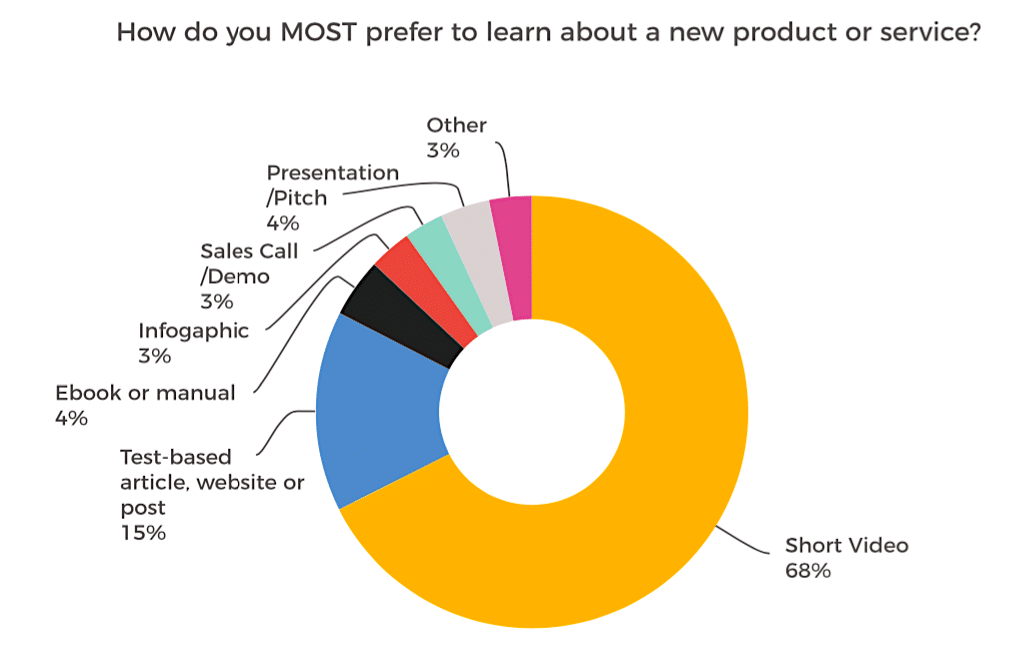
The FOMO Factor
The “Fear of Missing Out” is real, and it’s not going anywhere. Live videos still tap into this psychological trigger, making them irresistible to viewers. But now, brands are upping the ante with exclusive offers, behind-the-scenes looks, and real-time announcements that you really don’t want to miss.
Virtual Events and Webinars
The pandemic has shown us the power of virtual events, and this extends to live video. Webinars, virtual conferences, and even live product launches are becoming the norm, offering value that goes beyond the typical live stream.
When the live element is added, this makes video more engaging as the audience feels they’re a part of it and can influence the content, rather than just passively watching.
Live video is great for grabbing the attention of your social audience on Facebook or Instagram. These types of videos are so attractive to viewers because they tap into “FOMO” or fear of missing out. When you’re not sure if a live video is going to contain a tidbit of information that you can’t get anywhere else, or it will mean you’re the first to find out about some new and exciting news, you’re going to want to watch it.
Gen Z Will Continue to Influence Marketing More Than Millennials
The marketing industry has been obsessed with Millennials for the past two decades. In fact, a Google search currently yields around 129 million results for the search term “millennials”, compared to only around 7.2 million for the previous “generation x”.
But the millennials of today have outgrown their caricature as a bunch of entitled 20-somethings. The first millennials are now approaching their 40th birthday. While this age group still makes up a significant proportion of the audience of many marketers, some predictions made about their importance have fallen short of the mark.
For example, the oft-quoted statistic that Millennials will make up 75% of the workforce by 2025 is now not only unlikely but rather impossible.
It’s 2020 and Millennials have already peaked as a percentage of the adult population, making up just over 40% of the global population. By 2030 this percentage is expected to drop to just under 37% as Generation Z starts to come of age.

Generation Z consists of people who were born from 1995 to 2010. These young people have grown up in a digital world and have very different viewpoints than generations that came before them. They’re also more diverse than any other generation in history.
A more diverse audience can make content marketing challenging, but it also opens up more opportunities to reach different segments of that audience through personalization.
If you’ve been focusing your marketing strategy on Millennials, it may be time to take a step back and come up with some new ideas for reaching the workforce and decision-makers of tomorrow.
Growth in Emerging Markets and a More Diverse Audience
Emerging markets in Asia have grown significantly over the last decade and are expected to continue to grow over the next ten years.
Over a billion new middle-class consumers from countries like China, India, and Indonesia will be added to the global pool of consumers.
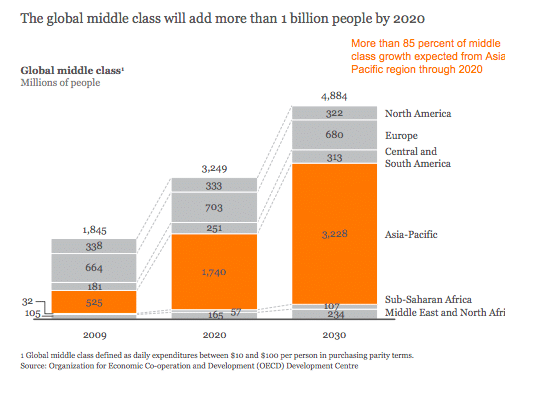
Companies that want to expand their marketing efforts beyond North America and reach these new consumers will have to think carefully about how best to reach them.
Different cultures, languages, social norms, and online behaviors can all make marketing a challenge when it comes to creating content for these audiences.
For large global enterprises, having a local on-the-ground marketing team in their main market locations is often the answer.
But smaller businesses can market globally too. The key to success is embracing diversity from the inside. Companies that strive for a diverse workforce and corporate culture will find that marketing innovation flourishes naturally.
World Class Customer Experience
Every year is the year of the customer. We’re seeing a massive shift in beliefs about what marketing actually is. It’s no longer about trying to convince people to buy from or work with your company. Instead, the priority has moved towards providing fantastic customer experiences that will keep people coming back for more. When you focus on building a positive business culture and providing great service, the marketing almost takes care of itself.
Not only are customers impatient, but they also want those fish tacos delivered on a silver platter.
Okay, not literally. But they do expect a seamless experience from the first spark of interest to customer service after the sale. From personalized messaging that helps them solve problems to make a buying decision to a customer-focused culture throughout their customer journey, an experience that delivers quality across all channels is more likely to earn their business.
In addition to personalized marketing messages, find ways to listen and respond to their questions. Coordinate your digital marketing team with your sales and customer service teams to deliver quality throughout their experience.
The growth of online content has given consumers more power. They are no longer a passive party when it comes to learning about products. They’re not waiting for you to tell you how great your products are. Instead, they’re going out and doing their own research.
So you have to offer them something more than information. 73% of people say that customer experience is an important factor in their buying decisions, but currently only 49% of US consumers say that today’s companies provide a good experience.
What exactly makes a great CX? Efficiency, convenience, knowledgeable and friendly service, and easy payment options are what people value most in their customer experience. But aspects more traditionally considered as marketing’s domain are cited too: up-to-date technology, personalization, an easy mobile experience, brand image, and design all add up to the overall customer experience.
Building the kinds of relationships with customers that drive loyalty is worth every penny you spend. As the management experts at Bain and Company point out, a mere 5 percent boost in customer retention increases profit by 25 percent.
Can you imagine how your profits would soar if you went the extra mile to deliver the kinds of experiences that build not only loyalty, but qualified referrals as well? When you coordinate your digital marketing strategy with all your teams to deliver those kinds of experiences, you’ll grow your bottom line well beyond even your highest expectations.
In other words, you need to consider CX in every aspect of your marketing strategy. This is how you can provide a great experience in order to keep your customers and attract new ones.
In fact, as you go through this list, you’ll see that every trend is really just one factor of the overall customer experience.
Integrated Online-Offline Customer Experience
Physical stores with little online presence have been struggling more in recent years. For many businesses, the 2020 pandemic proved the final nail in the coffin, with the last six months seeing an unprecedented number of store closures.
Conversely, many online retailers and digital brands have thrived. Massive numbers of consumers have shifted to moving more and more of their purchases and everyday activities online.
However, physical stores are not doomed to become a relic of the past. Consumers still prefer physical stores. But brands must adjust their marketing strategy to take advantage of this increased digitalization.
In the future, stores will be more than just a place to do your shopping. They will be a place where brands can really engage with their customers and improve the customer experience.
Moreover, VR and AR technologies will bring more of the shopping experience to the home, improving the online shopping experience. Ikea already has an augmented reality app that allows customers to see items of furniture in their own home and several fashion brands have launched apps enabling shoppers to virtually try on clothing before they buy.
More and more brands are jumping onto this trend. For example, Nike has launched a number of “retail experiences” in recent years including terminals with product information and online ordering functionality, integration with customer smartphones, social media walls, interactive augmented reality installations, and more.
Responsible Consumerism
Today’s consumers are more aware than ever before of the effect their buying habits have on the environment and society.
People are taking more care over the products they choose to buy and the brands they choose to associate with.
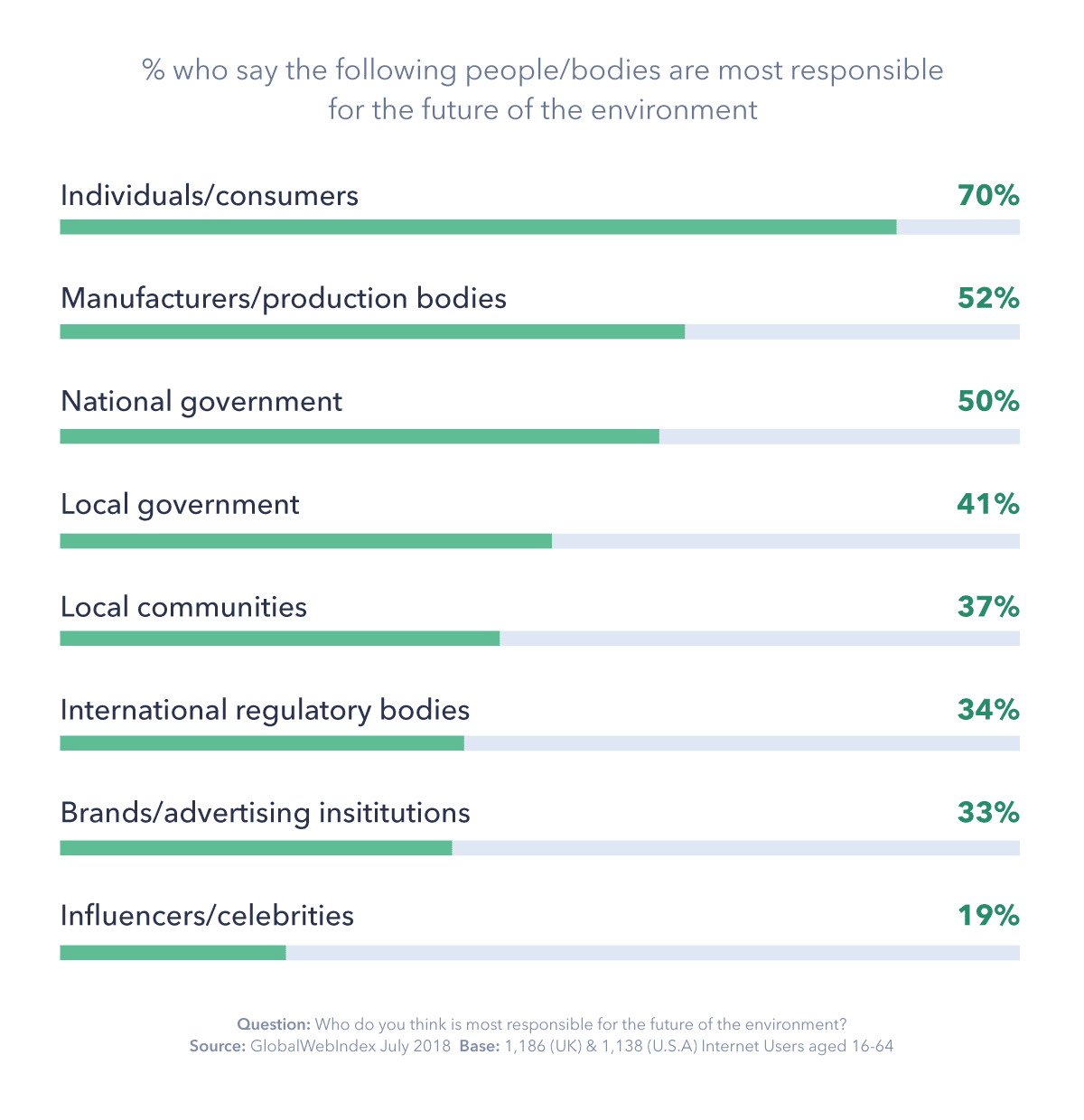
Many brands have already been making a move toward more sustainable practices to reduce their impact on the environment. However, social responsibility is becoming just as important as being “green”.
People are no longer just expecting the brands they support to avoid harmful practices. It’s now expected that corporations will actively fight injustice and support the causes they believe in.
In the near future brands will be expected to be ethical in all of their business practices and use their resources to be a force for good in the world. Those that don’t will be left behind as customers choose brands that align with their own values.
Brand responsibility goes beyond marketing. But marketing the things that a company is doing to make a positive difference in the world may end up being more effective than advertising its products.
Hyper-Local Marketing
Along with the growth of IoT devices and increased expectation for personalized customer experience comes increased used of geolocation data in marketing.
Local marketing is certainly not a new concept. Even the largest global brands recognize the value of customizing their marketing messages on a local level. And search engines like Google have become very good at serving up businesses in the local area whether you’re looking for a coffee or a new pair of shoes.
But geolocation services are due to step things up a notch. Eight in 10 marketers currently use location data in their marketing strategy and 94% plan to do so in the future.
Now that everyone has a smartphone, potential customers can be targeted with marketing messages as soon as they’re detected to be within a certain distance from a store.
Brands can use geofencing to deliver personalized messages to a very small set of individuals who are more likely to buy (location-based marketing has been found to be 20x more effective than standard ads.). This reduces marketing spend. Budget is not wasted on prospects who are less likely to result in a sale.
Combining geolocation and IoT technology means some very sophisticated and personalized marketing is possible. For example, a customer could get a reminder that they’re running low on eggs as they’re passing close to the grocery store.
Customer Retention, Loyalty and Advocacy
A huge part of providing a great customer experience is making sure that CX is ongoing and focused on keeping your existing customers, rather than just attracting new ones.
Recurring customers are more valuable than new customers. Studies have found that it costs five times as much to attract a new customer as it does to keep a new one, so it’s definitely worth putting in the effort to keep your customers happy.
Loyal customers also help to increase the reputation and awareness of your brand as they’ll talk about your company and products with their friends and family. Happy customers make great (and free!) brand ambassadors and influencers.
Many of the above-mentioned trends and technology can be helpful for increasing customer retention rates. Personalization, for example, is certainly expected from your existing customers if not your new ones, and it gets easier to personalize communications the more interactions someone has with your brand.
Relationship Marketing
After two tough years, consumers have migrated steadily toward businesses that see them as people, not just customers. Many consumers are also even willing to pay slightly higher prices in exchange for evidence that their concerns are taken seriously and promptly addressed.
One way companies can increase the number of positive interactions they have with customers is through creating content that doesn’t sound cookie cutter. Everyone can address frequently addressed questions from their customers, but is that what will make your company a trusted industry leader? Instead, focus on creating content that will set you apart from the competition. The marketing team at MarketMuse follows a 10x marketing formula where they research what their competitors are writing about and then make a conscious decision to cover other topics.
Customer satisfaction will steadily increase as a key indicator of the health of any business, regardless of industry. Your business may have the best prices and widest selection, but that’s not a guarantee consumers will choose your business. If your store is not welcoming or your content isn’t helpful and unique, consumers will shop elsewhere. The same metric applies to your website and social media presence. People want to feel valued and heard regardless of if they buy something or not.
Ongoing Audience Fragmentation
Customization of sales approach is the name of the game here. Business owners who increasingly customize their products and services to the felt needs of their customers will gain more loyalty points and sales. A middle-aged customer should have a different online experience with your business than a teenager.
While that may sound obvious, many online retailers are still presenting a “one size fits all” online experience. Unfortunately, website cookies are on the decline, with limiting policies already in place all across Europe. By leaning into contextual targeting as a cookieless advertising and tracking solution, retailers can continue to capture and retain customer-specific information without crossing any moral or legal boundaries.
The Rising Privacy Curve
As mentioned above, cookies are yesterday’s news. The issue of increased customer privacy will gain steam among consumers. They have already begun pushing back against “the Big Brother factor” in digital marketing.
Navigating the line between “we know who you are” and “we know way too much about you” can be tricky. This is especially true when trying to tailor the customer experience based on age, gender, geographic location, and so forth. Business owners who strike the proper balance will only collect the information they can act upon. After that, they’ll take whatever precautions are necessary to guard that information and protect it from an embarrassing data breach.
Staying Relevant: But Constantly Ask, To Whom?
Staying relevant is not just about tailoring your campaign to a specific audience, as mentioned above. While it certainly includes making your appeal to the right person, it also involves timing your appeal properly and delivering it when the customer is in the best position to respond positively. Relevance can be summed up succinctly with the phrase, “right time, right place, right message, right approach.”
Businesses can increase their ongoing relevance to customers by keeping track of purchases and leveraging that information to craft a timely message. For example, many vendors now send out emails that follow up on the value of a previous purchase, i.e. “How’s the new TV working out for you? Is there anything we can do to enhance your viewing experience?” Although messages like this have no sales pitch or other call to action, they demonstrate a commitment to the individual. This makes the business more relevant to the consumer’s daily life.
Effortless Messaging
Back in the days when website designers were falling all over themselves to design sites that were cool, edgy, and visually stunning, Steve Krug wrote a great book with a killer title: Don’t Make Me Think, Revisited: A Common Sense Approach to Web Usability. The simplicity and clarity of the title mirror the content of Krug’s philosophy. If your website, app, social media presence, or literally anything about your business causes your audience to have to think too long about the intent of your message, give yourself a zero.
Making Sustainability a No-Brainer
A growing percentage of clientele prefer to shop with companies that demonstrate care and concern for our planet. Pursue ways your business can make your products and service more environmentally friendly. But be wise about how you promote your initiatives as some consumers could see your effort as disingenuous. (If you blow a trumpet every time you do something good for Mother Nature, you’re more likely to arouse suspicions than build increasing customer loyalty.)
A lot of companies, perhaps eager to make sales at the expense of long-lasting credibility, have made the mistake of saying that they care about the environment but then engage in business practices that seem to indicate otherwise. Rest assured that any claims you make will be investigated by someone seeking to discredit you. The best way to “go green” is to look for opportunities to revise existing business practices rather than invent new ones. Encourage your employees to recycle their beverage containers in a central location, just for starters.
Get Ready for 2024
The emerging marketing trends above are not groundbreaking, but they may require your business to break new ground with technology, customer experiences, and everyday routines. As you seek to make positive changes on these six fronts, give yourself the grace to learn along the way. By focusing additional attention on doing right by customers, employees, the community, and the environment, we have a strong chance at simultaneously improving our bottom line!
While marketing trends come and go, the basics of success remain the same: understand the needs of your audience and communicate with them clearly and consistently. That’s why customer-focused content has always been the best way to establish solid relationships with your audience. It goes without saying that content marketing will continue to dominate the digital marketing landscape for some time to come. Most of these trends rely on content in some way. To have success in them you’ll need to have a solid base of quality content across all your marketing channels.
Now is the time to start planning your 2024 marketing strategy if you haven’t already. Make sure you start the New Year with a clear plan of your goals and how you’re going to achieve them.
Are you interested in engaging and converting new customers for your business using the most important digital marketing trend: consistent and quality content? Check out our weekly blog content service. Get started today and generate more traffic and leads for your business.


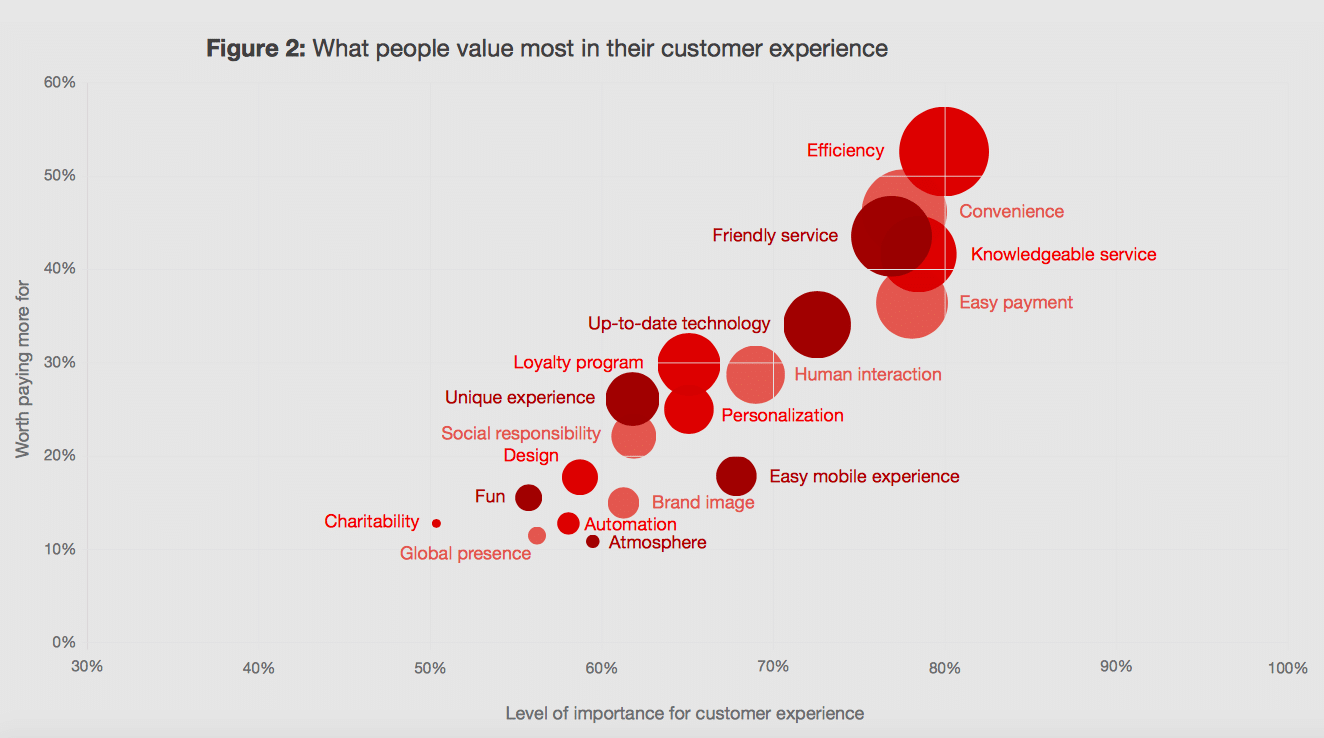

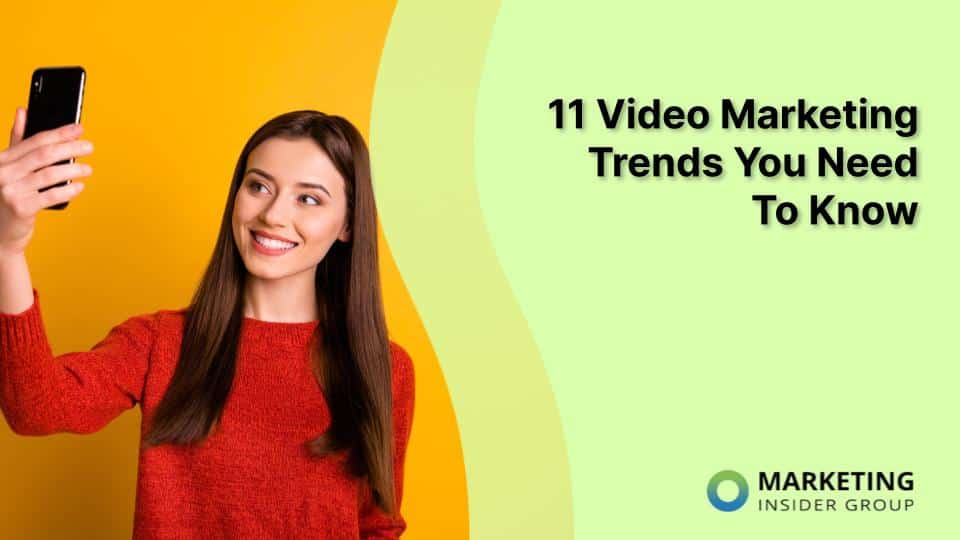


Really a very helpful post, Thanks for sharing with us.
My pleasure. Let us know what your favorite trend is?
Great research. your points resonate with reality and my experience.
My top 5 would have to be #4, #1, #5, #8, #9 (was hard to pick..)
Dan.
Good thing I have read this kind of article. It was very helpful, including your graphic research, it makes me understand it better. Thanks for sharing!
Thanks Paul! Really appreciate your support and kind words.
I really like all these blogs. Thank for sharing such a fantastic post.
Thanks so much Joanna!
Great article we have found a significant trend towards the digital marketing for traditional business during the Covid-19 pandemic. As you mentioned the live video has made a massive surge for our clients. thank you
Thanks Cory. Yes budgets are shifting out of traditional and into digital and also shifting out of ads and into content, mostly visual. Video is a great way to reach new people right now!
Thank you for sharing your ideas and tips! This is a very well detailed content.
Fantastic point on emerging markets. It is critical to consider the new markets and the affiliated spending power.
Thank you for the insight and for great articles like this. I’m using it with my high school Marketing students!
I love your articles, Michael. I feel like my brain expands with each read. I only wish everyone in marketing was reading along with me. Our industry would evolve by leaps and bounds.
Thanks Christina, you made my day!
Great read regarding a rundown of the various digital marketing trends nowadays as well as their benefits for continued business success. Thanks for this.
Hey Michael—thanks for this. Helpful content as always.
Dave
P.S. You might want to update the header graphic to say “2023” 😉
Thanks Dave, just done!